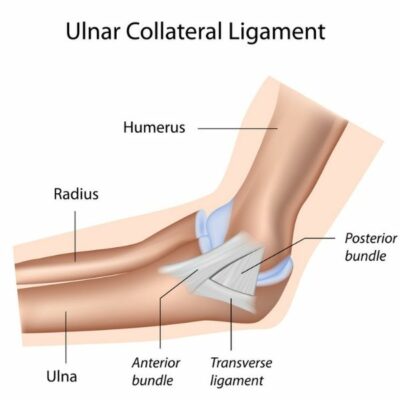UCL Injury Specialist

Are you an athlete who participates in repetitive overhead movements? If so, you may be at risk of developing an ulnar collateral ligament injury (UCL). The UCL is commonly injured in throwing activities or after an elbow dislocation, typically from a fall on an outstretched arm. UCL injury specialist, Dr. James Mazzara provides diagnosis and both surgical and nonsurgical treatment options for patients in Manchester, South Windsor, Enfield, Glastonbury and surrounding Hartford communities who have developed a UCL injury. Contact Dr. Mazzara’s team today!
What is a UCL Injury?
The ulnar collateral ligament (UCL) is a thick, triangular structure in the elbow that is critical for elbow stability. The UCL runs from the inner side of the humerus (arm bone) to inner side of the ulna (one of the bones in the forearm.) This ligament is designed to withstand a large amount of stress as it stabilizes the elbow joint. An ulnar collateral ligament injury can range from a mild stretch, to a complete tear and is usually seen in athletes or other active individuals who perform repetitive overhead motions. Dr. James Mazzara, elbow specialist serving Manchester, South Windsor, Enfield, Glastonbury and surrounding Hartford communities, is highly experienced in treating elbow pain associated with a UCL injury in a number of patients from worker’s comp to professional athletes.
How is a UCL injury classified?
Dr. Mazzara will classify an ulnar collateral ligament injury in the following categories:
- 1st Degree Sprain: This occurs when the ligament is strained but has not stretched. Elbow pain signals this degree of strain.
- 2nd Degree Sprain: When the ligament is stretched. Patients will experience increased pain or discomfort, but the elbow still functions normally.
- 3rd Degree Sprain: The ligament has been torn or ruptured. A UCL tear will cause loss of elbow function.
What causes an ulnar collateral ligament injury?
In most cases, a UCL injury is the direct result of a hard, forceful throw. Baseball pitchers, for instance, can experience a gradual onset of elbow pain due to repetitive stress on the ligament. A fall on an outstretched arm can also cause a UCL injury and is often concurrent with an elbow dislocation. Patients most at risk for a UCL injury:
- Participate in throwing sports: baseball, softball or javelin
- Play contact sports: football, rugby, lacrosse or any sport in which falling on an outstretched hand results in elbow dislocation
- Are involved in overhead sports: volleyball, tennis
- Have overhead working conditions: construction workers
- Use improper lifting or throwing mechanics
- Have poor conditioning
What are the symptoms of a UCL injury?
Symptoms may vary, depending on the severity of the UCL injury. Common patient complaints are:
- Elbow pain along the inside of the joint.
- A sudden “pop” with pain along the inside of the elbow. Is usually accompanied by the inability to continue throwing.
- Numbness and swelling in the elbow.
- Elbow instability
- Inability to throw at full speed
- Weakness in hand grip
*Young Athletes: It is important to note that it is not normal for young athletes, especially those under the age of 15, to experience elbow pain when throwing. This needs to be addressed immediately to prevent further injury.
How is a UCL Injury diagnosed?
Dr. Mazzara will conduct a thorough physical examination of the elbow and medical review of the patient’s history to reach a diagnosis. He will conduct a valgus stress test which tests the elbow for instability to assess the condition of the UCL. During this test, Dr. Mazzara will place pressure toward the inside of the elbow as the joint is moved to observe gapping of the joint and test for medial elbow pain. X-rays and an MRI may be recommended to rule out any bone injuries or associated elbow ligament injuries.
What is the treatment for an ulnar collateral ligament injury?
The treatment of a UCL injury depends on patient’s age, patient’s activity level and extent of the ulnar collateral ligament tear.
Does a UCL injury require surgery?
Initial treatment for a mild, or 1st degree UCL injury consists of ice and medication to reduce pain and swelling of the elbow. Rest from the activity is recommended and in more severe cases a brace or splint may be utilized. Dr. Mazzara may recommend physical therapy or to have an athlete’s mechanics evaluated and corrected to avoid further damage.
How is a UCL injury treated with surgery?
If the UCL injury is too severe or doesn’t respond to non-surgical treatment, Dr. Mazzara may recommend surgery. Often a minimally invasive technique can be used to perform a reconstruction procedure known as “Tommy John” surgery. During this arthroscopic repair, Dr. Mazzara will use a patient’s own forearm tissue to reconstruct the damaged ligament. If the patient’s own tissue cannot be used, a donor tissue called an allograft will be used.
Following UCL surgery, patients are required to wear a brace or approximately 6 weeks. Physical therapy can begin early in the post-operative period, which will be progressive. Most patients can begin a throwing program 4 months after surgery. A return to competitive throwing can take as long as 9-12 months.
For additional resources on ulnar collateral ligament tears or to determine the best treatment for your UCL injury, please contact the orthopedic office of Dr. James Mazzara, elbow specialist, serving patients living in Manchester, South Windsor, Enfield, Glastonbury and surrounding Hartford Connecticut communities.
